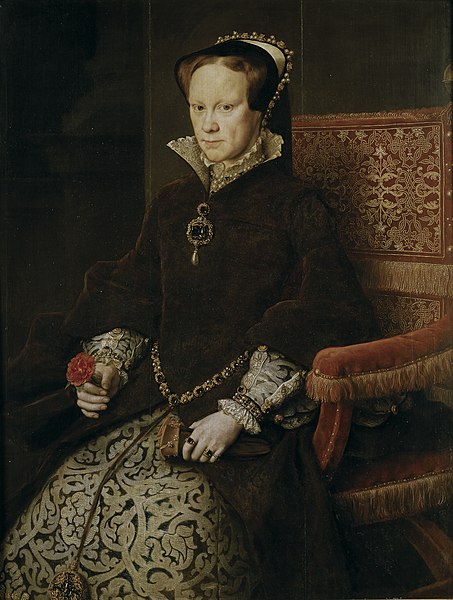Edward VI (1537 - 1553)

Edward was king of England for only a few years, and died at 15, but his short reign saw the full-scale introduction of Protestantism.
Edward was born on 12 October 1537 at Hampton Court Palace, the only legitimate son of Henry VIII. Henry's desperation for a son had led him to divorce two wives, but Edward's mother, Henry's third wife Jane Seymour, died a few days after his birth. Edward was given a rigorous education and was intellectually precocious, although his health was never strong.
Edward became king at the age of nine, when his father died in January 1547. His father had arranged that a council of regency should rule on his behalf, but Edward's uncle, Edward Seymour, Duke of Somerset, took power and established himself as protector. Somerset and the archbishop of Canterbury, Thomas Cranmer, were intent on making England a truly Protestant state, supported by the young king. An English Prayer Book was issued in 1549 with an Act of Uniformity to enforce it.
In the summer of 1549, peasants in the West Country revolted in protest against the Prayer Book. Kett's Rebellion in Norfolk was focused on economic and social injustices. At the same time, the French declared war on England. The Norfolk rebellion was suppressed by John Dudley, Earl of Warwick. In the atmosphere of uncertainty, Dudley exploited his success by bringing about the downfall of Somerset, who was arrested and later executed. Although Dudley, later duke of Northumberland, never took the title of protector, this is the role he now assumed. Protestant reform was stepped up - the new Prayer Book of 1552 was avowedly Protestant. Altars were turned into tables, religious imagery destroyed and religious orthodoxy was enforced by a new and more stringent Act of Uniformity.
It soon became clear that Edward was suffering from tuberculosis and would not live long. Northumberland was determined that his religious reforms should not be undone, so he persuaded Edward to approve a new order of succession. This declared Mary illegitimate and passed the throne to Northumberland's daughter-in-law, Lady Jane Grey, who was a more distant descendant of Henry VIII. Edward died on 6 July 1553. However, Jane was only queen for a few days until, with overwhelming popular support, Mary took the throne.
Mary I (1516 - 1558)

The first queen to rule England in her own right, she was known as 'Bloody Mary' for her persecution of Protestants in a vain attempt to restore Catholicism in England.
Mary was born at Greenwich on 18 February 1516, the only surviving child of Henry VIII and Catherine of Aragon. Her life was radically altered when Henry divorced Catherine to marry Anne Boleyn. He claimed that the marriage was incestuous and illegal, as Catherine had been married to his dead brother, Arthur. The pope disagreed, resulting in Henry's break with Rome and the establishment of the Church of England.
Henry's allegations of incest effectively bastardised Mary. After Anne Boleyn bore Henry another daughter, Elizabeth, Mary was forbidden access to her parents and stripped of her title of princess. Mary never saw her mother again. With Anne Boleyn's fall, there was a chance of reconciliation between father and daughter, but Mary refused to recognise her father as head of the church. She eventually agreed to submit to her father and Mary returned to court and was given a household suitable to her position. She was named as heir to the throne after her younger brother Edward, born in 1537.
Edward VI succeeded his father in 1547 and, under the protectorate of the Duke of Northumberland, zealously promoted Protestantism. Mary, however, remained a devout Catholic. When it became clear that Edward was dying, Northumberland made plans for his daughter-in-law, Lady Jane Grey, to take the throne in Mary's place.
On Edward's death in 1553, Jane was briefly acclaimed queen. But Mary had widespread popular support and within days made a triumphal entry into London. Once queen, she was determined to re-impose Catholicism and marry Philip II of Spain. Neither policy was popular. Philip was Spanish and therefore distrusted, and many in England now had a vested interest in the prosperity of the Protestant church, having received church lands and money after Henry dissolved the monasteries.
In 1554, Mary crushed a rebellion led by Sir Thomas Wyatt. Making the most of her advantage, she married Philip, pressed on with the restoration of Catholicism and revived the laws against heresy. Over the next three years, hundreds of Protestants were burned at the stake. This provoked disillusionment with Mary, deepened by an unsuccessful war against France which led to the loss of Calais, England's last possession in France, in January 1558. Childless, sick and deserted by Philip, Mary died on 17 November 1558. Her hopes for a Catholic England died with her.
No comments:
Post a Comment